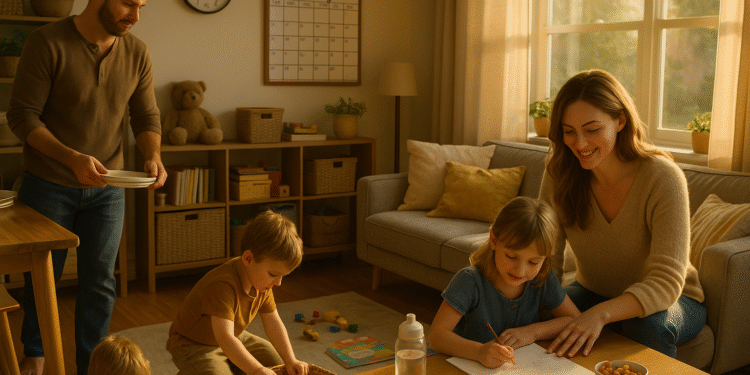Modern family life can feel chaotic. There are meals to prepare, toys scattered everywhere, crying fits, school runs, bedtime routines, work demands — and somehow, you’re supposed to enjoy it all?
But what if the goal wasn’t perfection — just a bit more peace?
The truth is, you don’t need a bigger house, more money, or more time to feel less overwhelmed. You need habits — small, intentional changes that reduce stress, build connection, and help everyone breathe more easily at home.
Here are 10 family habits that can transform your everyday life from survival mode to something calmer and more connected.
1. Create Predictable Routines (But Stay Flexible)
Kids thrive on rhythm. Knowing what comes next helps them feel secure — and reduces power struggles.
Try consistent routines for:
- Mornings
- Mealtimes
- Nap and bedtime
- After-school transitions
You don’t have to run a strict schedule. Just create flow — and stick to it 80% of the time.
2. Make One-On-One Time a Priority
Even 10 minutes of focused time with each child per day can reduce attention-seeking behavior and sibling rivalry.
Call it “special time” and let your child choose the activity:
- Reading a book
- Playing pretend
- Drawing together
- Just lying in bed and talking
Presence over perfection. That’s what matters.
3. Declutter Together
Less stuff = less stress.
Clutter causes visual overwhelm and mental fatigue. Involve your kids in the process:
- Use baskets for easy cleanup
- Rotate toys instead of offering everything at once
- Donate items together and talk about generosity
You don’t need a Pinterest-perfect house — just fewer things to trip over.
4. Create a Family Calendar (That Everyone Can See)
Post a whiteboard or paper calendar in the kitchen or hallway.
Include:
- Appointments
- School events
- Meal plans
- Special family activities
This helps kids feel included and gives everyone a visual cue of what’s coming.
5. Build Transitions Into the Day
Most tantrums and meltdowns happen during transitions — especially if they’re rushed.
Make transitions smoother by:
- Giving 5-minute warnings
- Using visual timers or music cues
- Offering a choice when possible (“Do you want to put on shoes or coat first?”)
It takes practice, but predictable transitions lower the emotional temperature in the house.
6. Practice “House Reset” Once a Day
Instead of trying to clean as you go all day (which is impossible with kids), choose one moment per day to do a full reset.
Involve the whole family for 10–15 minutes:
- Tidy toys
- Load dishes
- Wipe counters
- Light a candle or play calming music
This builds teamwork and helps everyone feel more in control of their environment.
7. Eat Together (Even If It’s Messy)
Family meals don’t have to be fancy. But sitting down together — without screens — fosters connection, conversation, and rhythm.
Aim for:
- No phones at the table
- Sharing “one good thing” from the day
- Letting kids help set or clear the table
Even if it’s takeout, the connection is what counts.
8. Use Visuals and Checklists for Kids
Instead of repeating yourself 30 times a day, create simple charts:
- Morning routine
- Bedtime steps
- Chore list
- Toy cleanup zones
Use pictures for younger kids. This gives them independence and lowers your mental load.
9. Establish “Quiet Time” (Even for Non-Nappers)
Once kids stop napping, peace disappears, right?
Not necessarily.
Introduce quiet time — 30 to 60 minutes of solo play, reading, or resting. Create a calm space with:
- Books
- Puzzles
- Headphones with music
- Audiobooks or calming podcasts
This protects your energy — and theirs.
10. Model Emotional Regulation (Not Perfection)
Your home’s atmosphere often mirrors your mood. You won’t be calm all the time — and that’s okay.
But when you:
- Name your emotions out loud
- Apologize when you lose it
- Take deep breaths in front of them
- Share healthy coping tools
… you teach your kids to do the same.
Final Thoughts
Peaceful family life doesn’t mean everyone’s smiling all the time. It means you’ve built systems and habits that support calm, even on messy days.
Start with one or two changes. Let them grow. And remember — it’s not about perfection.
It’s about presence, rhythm, and the belief that your home can feel like a safe place to land — for every member of the family.




